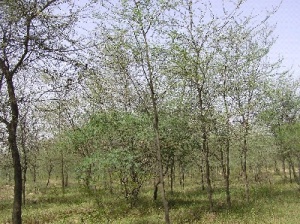Wild Life Area at Abohar
The Wild Life Sanctuary at Abohar, situated in the southern tip of Firozpur district, is unique in the sense that it is an open sanctuary made up of 13 revenue villages. These villages are inhabited by the Bishnoi community whose love for animals is legendary. The total area of the Sanctuary is 46,513 acres. It was declared as a Wild Life Sanctuary under the Wild Life (Protection) Act, 1972 in 2000. The main species found in the Sanctuary is the Black Buck (deer) which can be seen loitering around in the fields and homesteads, like cattle. In addition, other animals such as Nilgai, Wild boar, Porcupine, Jackal and Hare are all found here. These animals are protected by villagers as they don't let hunters kill them.
Abohar (Hindi: अबोहर Punjabi: ਅਬੋਹਰ) is a city and a municipal council in Firozpur district in the state of Punjab, India, located on the Ganganagar–Delhi railway route, nearly 50 km from Ganganagar. Sri Guru Nanak Khalsa College is only one of the many educational institutions of the area. Leading place in Punjab for agricultural research. In fact, Abohar has also been referred to as the "California of Punjab" for its rich soil, good irrigation sources, and particularly for the production of the Kinnow, a fruit of the orange family that was was first introduced to India at the Regional Fruit Research Station (Seed Farm). Abohar is also very famous for the cotton production and is one of the biggest cotton producing belt in all of North India.
Gurudwara Nanaksar, Abohar on Fazilka Road and the historical Gurudwara Badtirath in Haripura near Abohar, Panjpir attract people from the surrounding villages and nearby cities.

